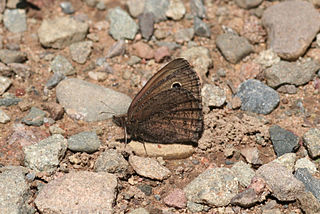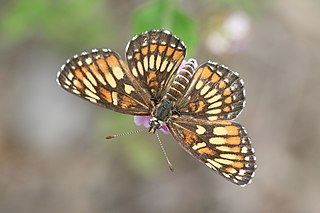
The common wood-nymph is a North American species of butterfly in the family Nymphalidae. It is also known as the wood-nymph, grayling, blue-eyed grayling, and the goggle eye.

Cercyonis oetus, the small wood-nymph or dark wood-nymph, is a butterfly of the family Nymphalidae. It is found in western North America.

Cercyonis is a genus of butterflies of the subfamily Satyrinae in the family Nymphalidae found in North America. They are commonly called wood-nymphs or wood nymphs.

Cercyonis sthenele, the Great Basin wood-nymph, is a North American butterfly in the family Nymphalidae.

Perlodinae is a subfamily of springflies in the family Perlodidae.
Euphilotes centralis, the central blue, is a butterfly in the family Lycaenidae. It was first described by William Barnes and James Halliday McDunnough in 1917. It is found in North America.

Speyeria nokomis, the nokomis fritillary, is a species of fritillary in the family of butterflies known as Nymphalidae. It is found in North America.
Cultus is a genus of stoneflies in the family Perlodidae. There are about five described species in Cultus.
Triploechus is a genus of bee flies, insects in the family Bombyliidae. There are about 10 described species in Triploechus.
Odontosciara is a genus of dark-winged fungus gnats in the family Sciaridae. There are at least 30 described species in Odontosciara.

Utacapnia is a genus of small winter stoneflies in the family Capniidae. There are about 11 described species in Utacapnia, found primarily in the Rocky Mountains of North America. Most species in this genus were first described by Alan V. Nebeker and Arden R. Gaufin.

Euphydryas anicia, the anicia checkerspot, is a species in the family of butterflies known as Nymphalidae. It was first described by Edward Doubleday in 1847 and it is found in North America.

Aeoloplides turnbulli, known generally as thistle grasshopper, is a species of spur-throated grasshopper in the family Acrididae. Other common names include the Russian thistle grasshopper and saltbush grasshopper. It is found in North America.

Melanoplus punctulatus, known generally as the pine tree spur-throat grasshopper or grizzly spur-throat grasshopper, is a species of spur-throated grasshopper in the family Acrididae. It is found in North America.

Chlosyne theona, the theona checkerspot, is a species checkerspots in the butterfly family Nymphalidae found in North America. The MONA or Hodges number for C. theona is 4508.

Euphilotes bernardino, the Bernardino blue, is a butterfly in the family Lycaenidae. The species was first described by William Barnes and James Halliday McDunnough in 1916. It is found in North America.
Monoclona is a genus of fungus gnats in the family Mycetophilidae. There are about 18 described species in Monoclona.

Historis odius, the orion cecropian, is a species of crescents, checkerspots, anglewings, etc. in the butterfly family Nymphalidae.

Orthogonis is a genus of robber flies. There are about 14 described species in Orthogonis.
Underwoodia is a genus of millipedes in the family Caseyidae. There are at least three described species in Underwoodia.














